
 Bill Burhans served as a tour officer with the USMLM Air Team from July 1971 to June 1975. He returned in 1979 to command Detachment 16,
7113th Special Activities Squadron (the Air Team), departing in early spring 1980 following a December 1979 Soviet-originated nasty incident.
Bill Burhans served as a tour officer with the USMLM Air Team from July 1971 to June 1975. He returned in 1979 to command Detachment 16,
7113th Special Activities Squadron (the Air Team), departing in early spring 1980 following a December 1979 Soviet-originated nasty incident.
He relates here his first eventful tour as a trainee towards the Allstedt and Grossenhain airbases, covering some secondary targets at the same time.
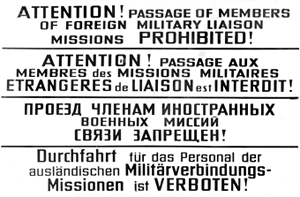 Les nombreux panneaux de restriction que posaient les autorités est-allemandes et soviétiques n'étaient pas reconnus par les missions militaires de liaison alliées.
Le personnel de ces dernières les arrachaient d'ailleurs bien volontiers... D'un autre côté, ces écriteaux signalaient bien involontairement la présence
d'installations sensibles dans la zone!
Les nombreux panneaux de restriction que posaient les autorités est-allemandes et soviétiques n'étaient pas reconnus par les missions militaires de liaison alliées.
Le personnel de ces dernières les arrachaient d'ailleurs bien volontiers... D'un autre côté, ces écriteaux signalaient bien involontairement la présence
d'installations sensibles dans la zone!
The numerous restriction signs erected by the Soviet and the East-German authorities were not recognized by the Allied military liaison
missions. The personnel of the latter tore them away willingly... On the other hand, those signs were a good indication of a potentially sensitive area!
On-the-job training (OJT) was the key element in successful job acclimatization. The Air Team USMLM approach to OJT was to pair the trainee with experienced tour officers and tour NCOs
for a minimum of one month. This was called “back-seating.” I have wonderful memories of those first few OJT training trips as a “back-seater” through the Iron Curtain. It meant being
out in the Zone four days a week for that month of training. I especially remember my very first trip in August 1971 when I traveled with Major Lynn Hansen and Technical Sergeant Nick
Netter to the southwestern part of the GDR.
I was involved in the tour planning from the very beginning. Major Hansen received a detailed briefing on the targets selected for coverage during this scheduled two-day reconnaissance tour.
The Air Team at this time was assigned to Area B (the southwest portion of East Germany) and the primary target each day was an airfield. On this tour, he was assigned the Soviet 294th Separate
Reconnaissance Aviation Regiment based at Allstedt and the Soviet 497th Fighter-Bomber Aviation Regiment at Grossenhain Soviet Airfield. The three of us studied the target folders to
determine collection requirements for these targets and to obtain updates on recent activity at these bases. We also checked into any recent changes that may have occurred in the surrounding
area (blocked trails, new construction, placement of mission restriction signs, and so on). We also reviewed the most recent coverage of each assigned target.
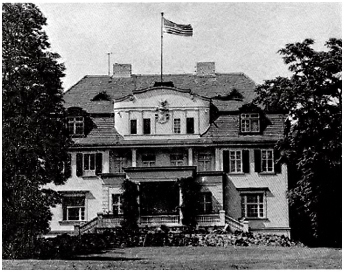 Le bâtiment de la USMLM en RDA, situé Am Lehnitzsee 7-9, Potsdam. © USMLM.
Le bâtiment de la USMLM en RDA, situé Am Lehnitzsee 7-9, Potsdam. © USMLM.
The Potsdam House or the USMLM residence in GDR,
located Am Lehnitzsee 7-9, Potsdam.
© USMLM.
The team went out to the Potsdam House, the official USMLM residence, the evening before our scheduled tour and enjoyed a movie. We awoke about 3 a.m. the next morning and were exceptionally
quiet as we dressed and packed the kiste (a box containing enough sandwiches, coffee in Thermos bottles, fruit and various snacks and desserts to cover the two days we would be out and about).
We quickly jumped into the car and headed down the long driveway, more than likely awakening and surprising the VOPO (1)
gate-guard on duty. By the time he reacted and notified the Stasi narks,
we were out of sight, headed for Allstedt Airfield, meaning we had about a 2-hour ride ahead of us.
My only task during this part of the tour was to attempt to follow along using the 1:100,000-scale maps of Area B. This was relatively easy compared to the more-detailed next step, keeping
up with each zig and zag through villages, fields, and wooded areas. The maps used in that case were 1:50,000 scale. When we made it to the vicinity of the airfield, I switched to the
1:25,000-scale target map.
Lynn Hansen and Nick Netter were experienced collectors and knew the target area like the backs of their hands. Lynn chose a preliminary observation point (pre-OP) from which we could monitor
any activity at Allstedt Soviet Airfield without being too close to an operating OP. He ensured we had at least two avenues of escape should we be discovered (this was standard operating
procedure). This pre-OP happened to be in a sort of gully, a cleft in the terrain wide enough to accommodate the vehicle and deep enough to hide us from sight. We settled in to wait in the
dark for something good to happen.
At about 8 a. m. we heard the sound of an aircraft engine and what certainly had to be a take-off. Almost immediately we observed an aircraft pass over us. It was the two-seat UTI MiG-15 MIDGET
“weather bird” carrying a crew tasked to investigate the weather conditions, not only in the vicinity of the airfield itself, but also in the area where flying training was planned for that day.
This was a very good sign - something was going to happen. They were going to fly! The adrenaline level shot up off the scale, and we prepared to move to a good close-in OP once the real activity
began. Disappointingly, nothing at all happened for quite a long time.
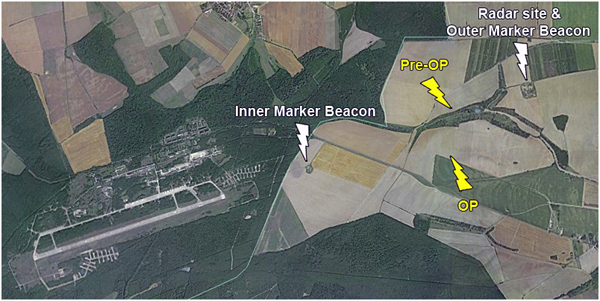
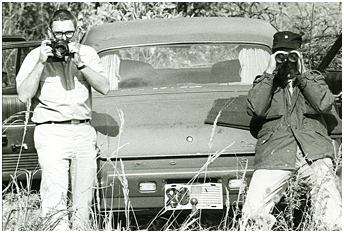 Bill Burhans et Lynn Hansen se détendent au point d'observation préliminaire près du site radar de Gatterstädt. Le numéro de plaque avait été trafiqué et camouflé... © B.Burhans.
Bill Burhans et Lynn Hansen se détendent au point d'observation préliminaire près du site radar de Gatterstädt. Le numéro de plaque avait été trafiqué et camouflé... © B.Burhans.
Bill Burhans and Lynn Hansen fooling around in the pre-OP in the gully near the Gatterstädt radar site. Note how they attempted to "camouflage" their identity by smudging up the license plate
and changing the number... © B.Burhans.
The gully Lynn had chosen was between the Gatterstädt radar site (which also housed the airfield outer marker beacon about 5 kilometers from the end of the runway) and the inner marker beacon,
which was 1 kilometer from the runway threshold. We felt very secure in that pre-OP. Absolutely nothing was happening around us and the sunny mid-August morning heat was most conducive to drowsiness.
Lynn spotted a field of potatoes a few feet from the top slope of the gully and crawled out to investigate. He remembered his boyhood days in Idaho and wanted to compare the quality of the
German potato to that of the famed product of his home state. Out came the jackknife and off came a few slices for us to try. Not bad, actually!
We had been in this pre-OP lying next to the car with our shirts off getting some “rays” when we were surprised by the sound of voices. While we all had been dozing, two Soviet soldiers had
walked up almost right on top of us before we knew it. I had a cup of cold coffee in my hand and, when I leaped up, I sprayed cold liquid on my compatriots. We all jumped into the car and
sped away. As we departed we noticed these soldiers were working very hard not to pay any attention whatsoever to us. It was as if they had chosen not to see us, probably because they did
not want to have to report our presence and become involved in any reaction, attempted detention or resulting bureaucratic hassles.
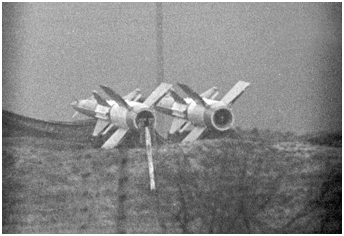 Des missiles 5V27 positionnés sur une double rampe de lancement 5P71 - système anti-aérien S-125 Neva (SA-3B GOA) - protégeant un aérodrome soviétique de RDA. © USMLM.
Des missiles 5V27 positionnés sur une double rampe de lancement 5P71 - système anti-aérien S-125 Neva (SA-3B GOA) - protégeant un aérodrome soviétique de RDA. © USMLM.
A 5V27 missile battery - S-125 Neva SAM system (SA-3B GOA) - defending a Soviet airfield in the GDR. © USMLM.
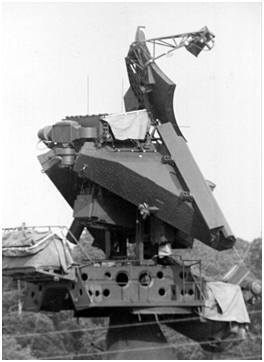 Un radar de poursuite et de tir SNR-125 "LOW BLOW" surveille le ciel au-dessus d'un aérodrome en RDA. © USMLM.
Un radar de poursuite et de tir SNR-125 "LOW BLOW" surveille le ciel au-dessus d'un aérodrome en RDA. © USMLM.
A SNR-125 'LOW BLOW'
tracking, fire control and guidance radar watching the sky above an airfield in the GDR. © USMLM.
There was an SA-3 surface-to-air missile site located to the west of every Soviet airfield to defend them against a NATO low-altitude attack. The Allstedt SAM site was one of our alternate
targets. Although such sites had a static inventory, sometimes something new or unusual requiring close coverage would appear. For example, the replacement of the two-missile
erector-launchers by a four-missile version was first noted during a “routine” equipment check at this site in 1981.
We made our way cross-country to an OP atop a hill overlooking this site accessible via a trail from a hard-surface road at the edge of a cultivated field. We looked down into the site and made
our observations, taking a visual and a photographic inventory of the installed electronic and missile equipment.
We noted that the instrument panel doors on the LOW BLOW target tracking and missile guidance radar were open so we attempted to get good photography of that portion of the array. There was
nothing else out of the ordinary at the site on this occasion so we headed back down the track toward the main road. Awaiting us there was a VOPO
on his Moped! He had placed his motorbike across
the track to block our passage. When we reached him, he held up his hand and told us to halt. I am sure he thought he had caught a real prize and would certainly receive a commendation for
detaining an Allied military liaison mission reconnaissance tour.
Instead, the vehicle continued to creep slowly forward towards him, at which point he became agitated. He vigorously shouted at us: “Halt!”. Lynn, a fluent German speaker, leaned out of the
window and told him to move his vehicle or we would run over it. Blasphemy - when a VOPO speaks, everyone listens up! Much to the VOPO’s surprise and chagrin, that was not to be the case in this
instance. Since he did not move, we simply continued forward and, in fact, ran over the rear wheel of his motorbike. The last we saw of him, he was hopping mad and waving and shouting at our
departing vehicle.
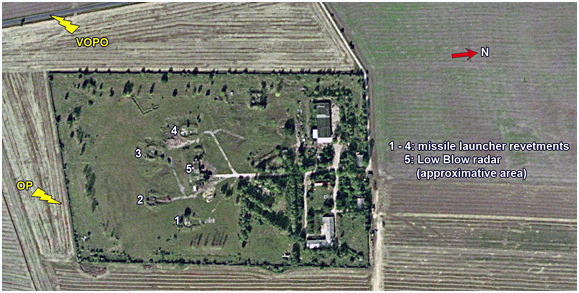
The Allstedt SA-3 site located at Klosternaundorf
notes
(1) VOPO: Volkspolizeï or People's Police.
 |
My first back-seat tour > Part 2 |
 |
Plan du site - Sitemap |  |
